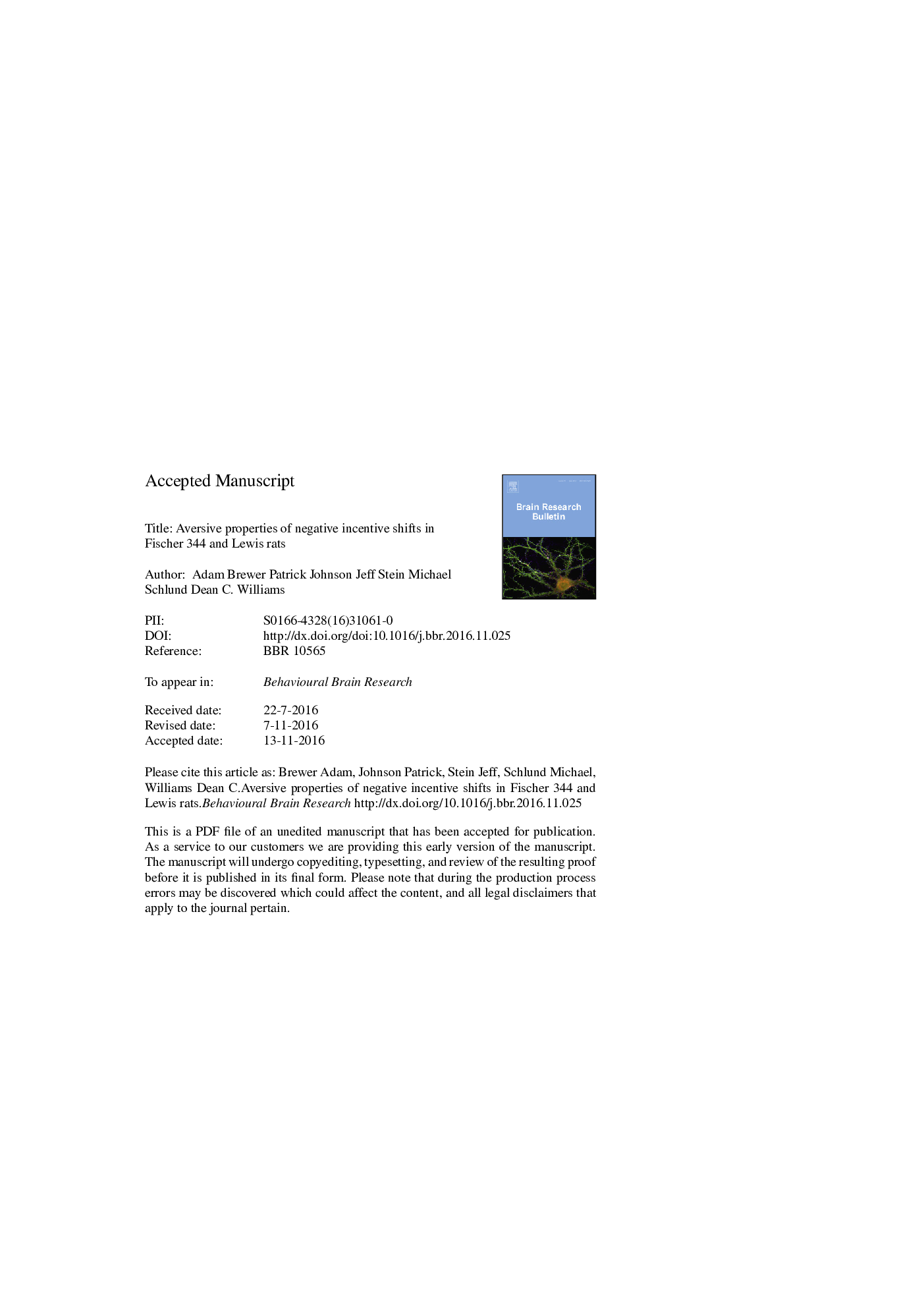| کد مقاله | کد نشریه | سال انتشار | مقاله انگلیسی | نسخه تمام متن |
|---|---|---|---|---|
| 5735299 | 1612914 | 2017 | 25 صفحه PDF | دانلود رایگان |
عنوان انگلیسی مقاله ISI
Aversive properties of negative incentive shifts in Fischer 344 and Lewis rats
ترجمه فارسی عنوان
خواص غلطی از تغییرات انگیزه منفی در موش های فیشر 344 و لوئیس
دانلود مقاله + سفارش ترجمه
دانلود مقاله ISI انگلیسی
رایگان برای ایرانیان
کلمات کلیدی
کنتراست منفی، فیشر 344 موش، موش های لوئیس، هزینه، عاطفی جایزه،
ترجمه چکیده
تحقیقات در مورد کنش انگیزشی نشان می دهد که ارزش پاداش مطلق نیست، بلکه بر مبنای مقایسه هایی است که ما برای پاداش هایی دریافت می کنیم که انتظار می رود دریافت می کنیم. مطالعات انسانی و غیر انسانی در مورد کنتراست انگیزشی نشان می دهد که تغییر از پاداش بیشتر ارزشمند به پاداش کمتر از ارزش کمتر با مدت طولانی عدم پاسخ - اثر کنتراست منفی است. در این تحقیق، از دو نوع موش های ژنتیکی موش، موش های فیشر 344 و لوئیس استفاده شده است که به نظر می رسد حساسیت آنها نسبت به تحریک انسدادی متفاوت است، برای ارزیابی خواص منفجره تغییرات پاداش بزرگ (تغییرات انگیزشی منفی). علاوه بر این، ما اندازه گیری کردیم که هزینه افزایش (نیازهای ثابت نسبت) منعکس کننده اثرات کنتراست منفی است. در حضور نشانه ای که میزان پاداش آینده را نشان داد، فشار دادن فشار توسط یکی از دو مقدار مختلف غذا (بزرگ یا کوچک) تقویت شد. این طرح دو تغییر کنتراست (کوچک به بزرگ، بزرگ به کوچک) و دو شیفت را به عنوان شرایط کنترل (کوچک به کوچک، بزرگ به بزرگ) ایجاد کرد. نتایج نشان داد که اثر متقابل بین موش صحرایی و هزینه تنها در طی تغییر انگیزه منفی با موش های فیشر 344 واکنش پذیر احساس عجیب و غریب را با افزایش هزینه افزایش می دهد و منعکس کننده کنتراست منفی بیشتر است. این یافته ها بیشتر با حساب های احساسی کنتراست منفی مطابقت دارد و نتایج تحقیقات نوروفیزیولوژیکی نشان می دهد که تغییر از یک بزرگ به یک پاداش کوچک منفی است. یافته ها همچنین نشان می دهند که ارزش پاداش و انگیزه ی ذهنی یک محصول تعاملات ژن و محیط است.
موضوعات مرتبط
علوم زیستی و بیوفناوری
علم عصب شناسی
علوم اعصاب رفتاری
چکیده انگلیسی
Research on incentive contrast highlights that reward value is not absolute but rather is based upon comparisons we make to rewards we have received and expect to receive. Both human and nonhuman studies on incentive contrast show that shifting from a larger more-valued reward to a smaller less-valued reward is associated with long periods of nonresponding - a negative contrast effect. In this investigation, we used two different genetic rat strains, Fischer 344 and Lewis rats that putatively differ in their sensitivity to aversive stimulation, to assess the aversive properties of large-to-small reward shifts (negative incentive shifts). Additionally, we examined the extent to which increasing cost (fixed-ratio requirements) modulates negative contrast effects. In the presence of a cue that signaled the upcoming reward magnitude, lever pressing was reinforced with one of two different magnitudes of food (large or small). This design created two contrast shifts (small-to-large, large-to-small) and two shifts used as control conditions (small-to-small, large-to-large). Results showed a significant interaction between rat strain and cost requirements only during the negative incentive shift with the emotionally reactive Fischer 344 rats exhibiting significantly longer response latencies with increasing cost, highlighting greater negative contrast. These findings are more consistent with emotionality accounts of negative contrast and results of neurophysiological research that suggests shifting from a large to a small reward is aversive. Findings also highlight how subjective reward value and motivation is a product of gene-environment interactions.
ناشر
Database: Elsevier - ScienceDirect (ساینس دایرکت)
Journal: Behavioural Brain Research - Volume 319, 15 February 2017, Pages 174-180
Journal: Behavioural Brain Research - Volume 319, 15 February 2017, Pages 174-180
نویسندگان
Adam Brewer, Patrick Johnson, Jeff Stein, Michael Schlund, Dean C. Williams,
